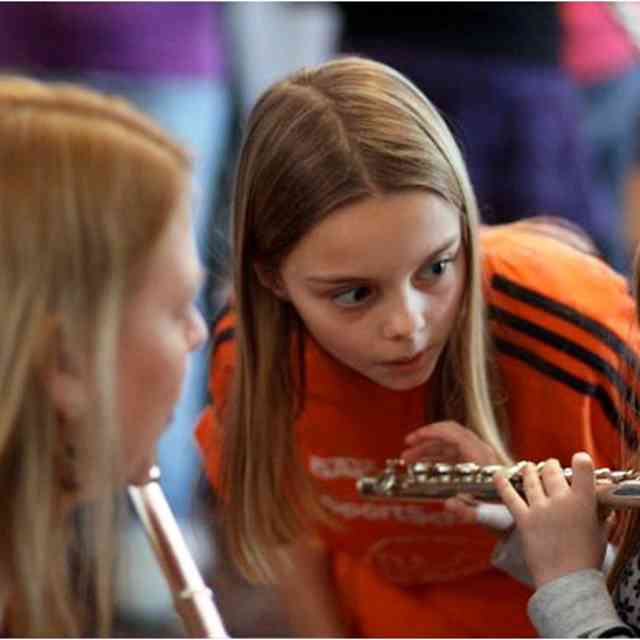From the video series Parents As Partners Online 2016
When we embark on a project as important as preparing our children for the role that music will play in their lives, it’s only natural that we concern ourselves with a host of issues. Once our major decisions are made such as choosing an instrument and selecting a teacher, we become absorbed in the initial stages of learning the basics. Things like establishing good practice skills, making habits of good position and producing a beautiful tone.
Inevitably, we start to ask, “So…how are we doing? How do we stack up against the other families in our program? In our area? Or at institutes?”
We certainly have many models outside of the Suzuki method that encourage us to take measurements and make comparisons. We have growth and development charts for infants to see how each child compares to the norm. In school, we have graded tests to measure the degree to which the child has understood and learned the subject matter. In this classroom environment, regardless of the individual child’s earned grade, the whole class moves on to the next unit.
You might find some similarities to these benchmarks in the way that the Suzuki repertoire is organized. Perhaps relating the pieces to units and the books to grade levels. But that’s where the similarities end. The differences in measuring each student’s progress are vast.
First of all, there is no test to determine the readiness to move on to a new piece, but rather readiness is gauged by the teacher’s continuous assessment of skills. There are no grades awarded to this progress. In the Suzuki method, once we learn a piece, we continue to review it. We elevate the music to a higher level of performance and understanding with each visitation. Assigning a grade becomes senseless when pieces are experienced on a continuum. We may move on to a higher book, but we never abandon our pieces since they remain works in progress.
The Suzuki repertoire is carefully selected so that skills are required in sequence. In order to achieve success, each skill must be mastered before another layer can be added. Just because the notes in a piece have been learned and memorized, does not necessarily mean that the inherent skills have been mastered. Accumulating repertoire is not our ultimate goal. Rather, our focus is on developing the student’s excellent technical skills flexibility, ease of playing confidence, independence, group skills and fine character. The emphasis is on quality rather than quantity.
While the Suzuki philosophy teaches us that every child can learn, every child will develop at a different rate. There are so many factors that will influence a child’s rate of progress that it is impossible to fairly compare one child to another. Consider the following differences among individual children.
-
Physical differences: Some children seem born to play a particular instrument. Simple traits such as joint flexibility, limb length or reflex speed might influence how easy it is to learn an instrument, but these elements won’t affect the overall potential of reaching a high level of performance. More severe differences such as autism spectrum, hearing loss, or processing disorders will certainly slow progress, but the benefits of learning an instrument are perhaps even more dramatic.
-
Environmental factors: Allergies, medications, nutrition, lack of sufficient sleep, or even the distraction from ambient noise can all make it very difficult for a child to focus and concentrate during practice—abilities which are crucial to making progress.
-
Learning differences: Some children need to hear something to learn it easily. Some need to see it. Some need to figure it out for themselves. It’s a rare child who only needs to repeat a section only five times in order to make it easy; most will need many more. It’s for this reason that Dr. Suzuki, “Ability equals knowledge plus 10,000 times.” The important thing is to tailor instruction and practice to the needs of the child.
-
Family makeup and priorities: The number of working parents in the home, the number of siblings, the number of activities that fill a child’s schedule. The importance and priority allocated to musical activities. Even the number of Parents as Partners Videos viewed by the parent. All of these factors will have an effect on the child’s ability and desire to make progress, and the parent’s ability to help him or her.
-
The establishment of practice habits: Let me reiterate that I mean practice habits which place the priority on developing excellent technical and musical skills. As well as a beautiful attitude and character. How much importance is placed on listening and review? Does practice occur daily and at a time when energy and attention are good? In determining the amount of time spent practicing, is there a balance between the time needed to cover lesson assignments and consideration for what is appropriate for the age and temperament of the child? Is the time spent practicing used efficiently? Are practice sessions most often positive experiences for both parent and child?
-
Expectations and standards vary from teacher to teacher. It’s’ important to find a good fit for you and your child. Fortunately, because of the shared philosophy, as well as the extensive training and mentorship available amongst Suzuki teachers, there’s likely to be a general agreement and consistency whether you move across the country or encounter new teachers at workshops and institutes.
Your child is unique. Your situation is unique. There is no true comparison to be made. If you want to assess your child’s progress, ask yourself these questions.
Is my child gaining fluency on her instrument?
Are his listening skills becoming more refined?
Is she gaining independence through self-evaluation?
Are we all putting forth our best effort?
Is our understanding and love of music growing?
And most importantly:
Is my child developing fine character and a beautiful heart?
**







